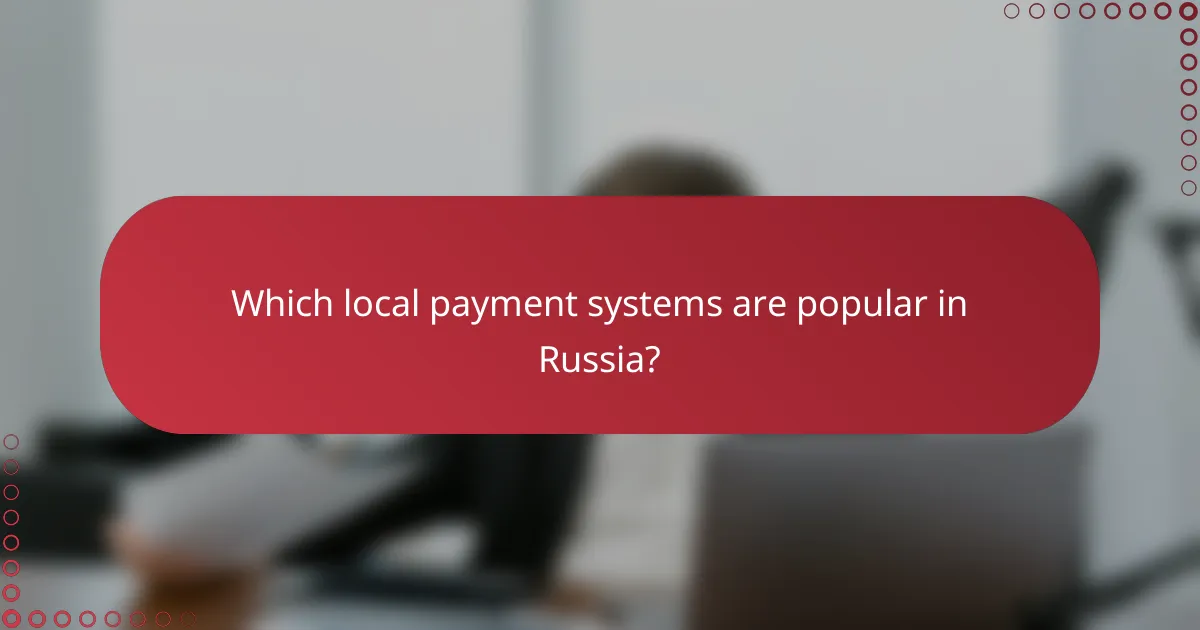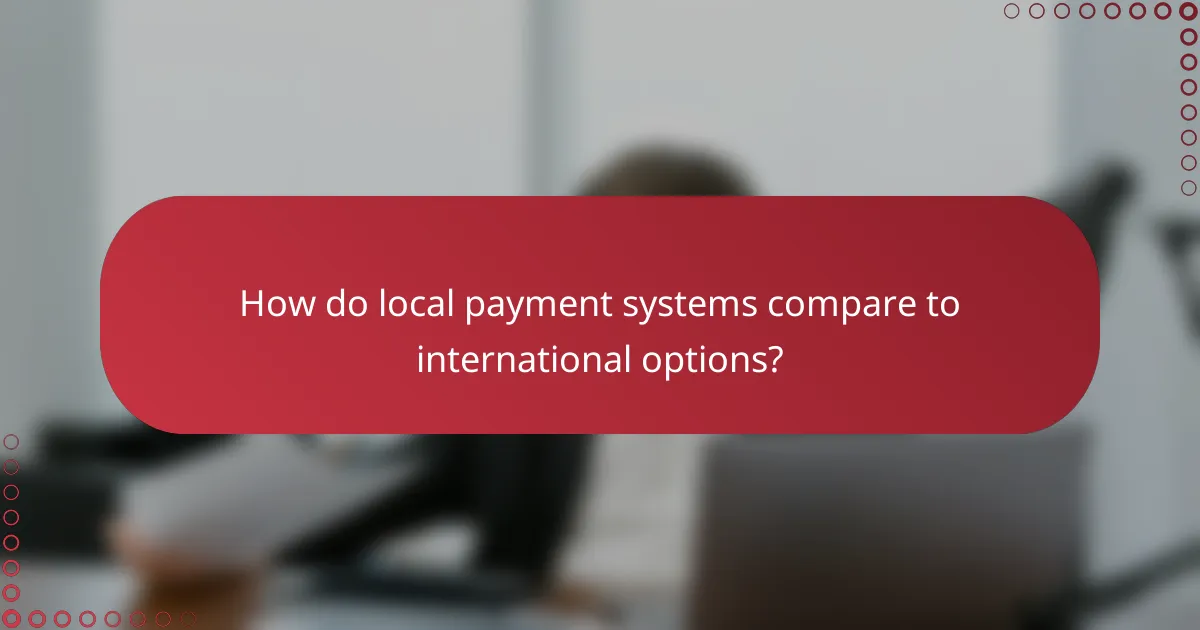Leveraging local payment systems in Russia can greatly enhance conversion rates by aligning with consumer preferences and streamlining the checkout process. By integrating familiar and trusted payment options such as YooMoney, Qiwi Wallet, and WebMoney, businesses can create a more seamless shopping experience, ultimately leading to higher completion rates and customer satisfaction.

How can local payment systems increase conversions in Russia?
Local payment systems can significantly boost conversions in Russia by aligning with consumer preferences and enhancing the overall shopping experience. By offering payment options that are familiar and trusted, businesses can reduce friction during the checkout process, leading to higher completion rates.
Enhanced customer trust
Using local payment systems fosters trust among Russian consumers. When customers see familiar payment options, they feel more secure and confident in completing their purchases. This trust is essential in a market where online fraud concerns are prevalent.
For instance, integrating popular local payment methods like Yandex.Money or Qiwi can reassure customers that their financial information is being handled securely. This trust can translate into increased sales and customer loyalty.
Familiarity with payment methods
Familiarity with local payment methods encourages customers to complete their transactions. Many Russian consumers prefer using local services due to their ease of use and established reputation. Offering these options can make the payment process feel more intuitive.
For example, allowing payments through Sberbank Online or WebMoney can cater to a broader audience, as these platforms are widely recognized and used in Russia. This familiarity can lead to a smoother checkout experience and fewer hesitations during the buying process.
Reduced cart abandonment
Implementing local payment systems can significantly reduce cart abandonment rates. When customers encounter payment methods they do not recognize or trust, they are more likely to abandon their carts. By providing familiar options, businesses can keep customers engaged until the transaction is complete.
Research indicates that offering multiple local payment options can decrease abandonment by a notable percentage. To optimize this, businesses should analyze their target audience’s preferred payment methods and ensure they are prominently featured during checkout.

Which local payment systems are popular in Russia?
In Russia, several local payment systems are widely used, significantly impacting online transactions and conversions. Key players include YooMoney, Qiwi Wallet, and WebMoney, each offering unique features and benefits tailored to the Russian market.
YooMoney
YooMoney, formerly known as Yandex.Money, is a leading electronic payment service in Russia. It allows users to make online purchases, pay bills, and transfer money easily through its website or mobile app.
To leverage YooMoney effectively, businesses should integrate its payment gateway, which supports various transaction methods, including bank cards and e-wallets. This flexibility can enhance customer experience and boost conversion rates.
Qiwi Wallet
Qiwi Wallet is another popular payment system that offers users a simple way to manage their finances. It provides options for online payments, money transfers, and even cash deposits through numerous kiosks across Russia.
For businesses, incorporating Qiwi Wallet can attract a broader audience, especially among younger consumers who prefer mobile payments. Ensure your checkout process includes Qiwi to cater to this demographic effectively.
WebMoney
WebMoney is a well-established payment system that allows users to conduct transactions in a secure environment. It offers a range of services, including online payments, currency exchange, and even loans.
When using WebMoney, businesses should be aware of its complex registration process and the need for users to verify their identity. While this may deter some customers, it can also enhance trust among those familiar with the platform. Consider offering guidance on the registration process to facilitate user adoption.

What are the benefits of using local payment systems?
Using local payment systems in Russia can significantly enhance conversion rates by providing customers with familiar and trusted payment options. These systems often cater to local preferences, improving the overall shopping experience and reducing barriers to purchase.
Lower transaction fees
Local payment systems typically offer lower transaction fees compared to international alternatives. This can lead to cost savings for businesses, which can be passed on to customers or reinvested into marketing efforts.
For example, while international payment processors may charge fees in the range of 2-4%, local options might only require 1-2%. This difference can accumulate significantly over time, especially for businesses with high transaction volumes.
Faster payment processing
Local payment systems often provide quicker payment processing times, which can enhance customer satisfaction. Transactions can be completed in low tens of milliseconds, allowing for near-instant confirmation of payments.
In contrast, international systems may take several minutes to process, leading to potential cart abandonment. By utilizing local options, businesses can ensure a smoother checkout experience.
Localized customer support
With local payment systems, businesses benefit from customer support that understands the local market and language. This can lead to quicker resolutions of issues and a better overall customer experience.
For instance, if a customer encounters a problem with a payment, they can receive assistance in Russian, making communication clearer and more effective. This localized support can help build trust and loyalty among customers.

How to integrate local payment systems into your platform?
Integrating local payment systems into your platform is essential for enhancing conversion rates in Russia. This process involves selecting suitable payment gateways, implementing API integrations, and thoroughly testing the payment processes to ensure a seamless user experience.
API integration steps
To integrate local payment systems, start by identifying the APIs provided by your chosen payment gateway. Most gateways offer comprehensive documentation that outlines the necessary endpoints, authentication methods, and data formats.
Next, implement the API calls in your platform’s backend, ensuring to handle responses correctly. Pay attention to error handling and logging to troubleshoot any issues that may arise during transactions.
Choosing the right payment gateway
Selecting the right payment gateway is crucial for catering to Russian consumers. Look for gateways that support popular local payment methods such as Yandex.Money, Qiwi, and WebMoney, as these are widely used in the region.
Consider transaction fees, currency support, and integration complexity when making your choice. Some gateways may offer lower fees but have limited features, while others might provide extensive support at a higher cost.
Testing payment processes
Once the integration is complete, conduct thorough testing of the payment processes. Test various scenarios, including successful transactions, failed payments, and refunds to ensure all aspects function as expected.
Utilize sandbox environments provided by payment gateways for testing without affecting real transactions. Regularly review and update your testing protocols to adapt to any changes in payment regulations or gateway features.

What are the challenges of local payment systems in Russia?
Local payment systems in Russia face several challenges that can hinder their effectiveness and adoption. Key issues include regulatory compliance, fraud prevention measures, and technical integration difficulties that businesses must navigate to enhance conversion rates.
Regulatory compliance issues
Regulatory compliance is a significant challenge for local payment systems in Russia. Businesses must adhere to various laws, including those related to data protection and financial transactions, which can be complex and frequently changing.
For example, the Russian Federal Law on Personal Data requires companies to store personal data of Russian citizens on servers located within the country. Non-compliance can lead to hefty fines and restrictions on operations.
Fraud prevention measures
Fraud prevention is crucial for maintaining trust in local payment systems. Russian businesses often face high rates of online fraud, necessitating robust security measures to protect both consumers and merchants.
Implementing multi-factor authentication and transaction monitoring can help mitigate risks. Companies should also stay updated on common fraud tactics to adapt their strategies effectively.
Technical integration difficulties
Technical integration can pose challenges when adopting local payment systems in Russia. Many businesses struggle with connecting their existing platforms to new payment gateways, which can lead to delays and increased costs.
To ease integration, companies should choose payment providers that offer comprehensive support and documentation. Testing the integration thoroughly before going live can also help identify potential issues early on.

How do local payment systems compare to international options?
Local payment systems in Russia often provide advantages over international options, particularly in terms of familiarity and integration with local banking infrastructure. These systems can enhance conversion rates by streamlining the payment process for Russian consumers, who may prefer domestic solutions over foreign ones.
Transaction speed differences
Local payment systems typically offer faster transaction speeds compared to international options. While international transactions may take several days to clear due to cross-border regulations and processing times, local systems can often complete transactions in just a few seconds to a few minutes.
This speed is crucial for e-commerce businesses aiming to minimize cart abandonment. For instance, a payment made through a local service like Yandex.Money can be processed almost instantaneously, enhancing the overall shopping experience.
Cost-effectiveness analysis
Using local payment systems can be more cost-effective for businesses operating in Russia. Local providers usually charge lower transaction fees compared to international services, which often include additional costs for currency conversion and cross-border transactions.
For example, while international payment processors might charge around 3-5% per transaction, local systems may charge only 1-2%. This difference can significantly impact profit margins, especially for high-volume transactions.
User experience variations
User experience can vary significantly between local and international payment systems. Local options are often designed with the Russian consumer in mind, offering interfaces in Russian and familiar payment methods like Qiwi or WebMoney.
In contrast, international systems may not provide the same level of localization, which can lead to confusion or hesitation among users. Ensuring a seamless and intuitive payment process is essential for maximizing conversions, making local systems a preferred choice for many Russian consumers.



